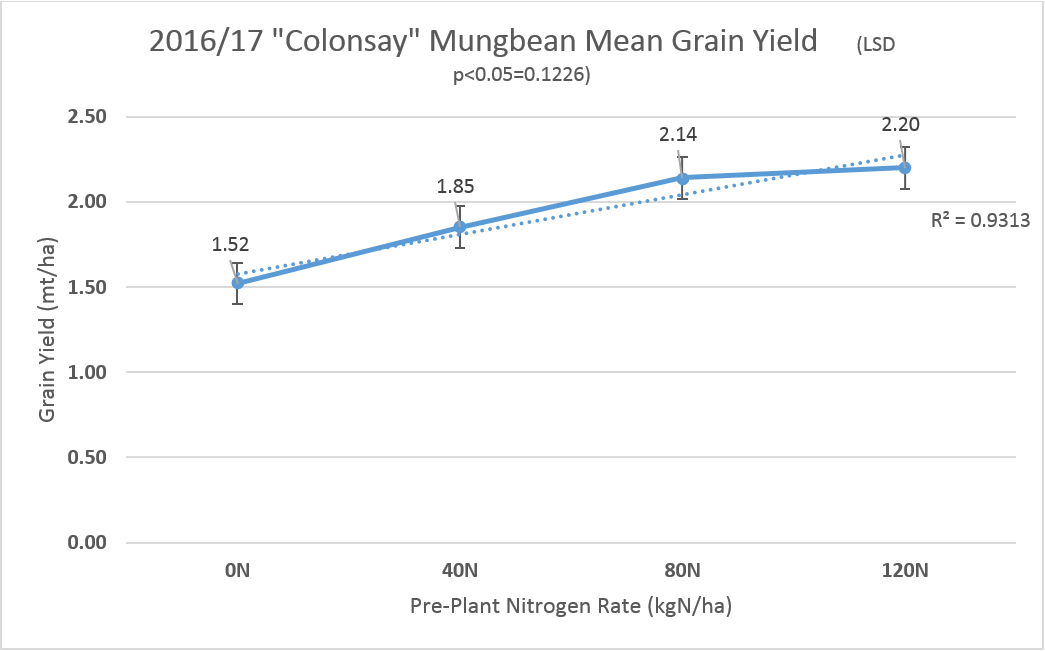Planning for top mungbean results
Aug 7, 2019Would you apply nitrogen to inoculated mungbean crops? Recent research is showing that while it might seem counter intuitive, applying nitrogen fertiliser can improve yields and returns in this fast-growing crop.
Click here to download this article
Mungbeans require up to 60 to 70 kg/ha of nitrogen per tonne of grain yield in favourable seasons. The crop will use nitrogen from the soil, nitrogen supplied by fertilisers and nitrogen fixed by the crop. The more nitrogen the crop can access, the more it will use. Work by University of Queensland researcher Dr Marisa Collins (from a GRDC-funded survey) shows that the top-performing mungbean paddocks started with >65 kg/ha of nitrogen in the profile.
Soil testing is the only way for growers and their advisers to know how much nitrogen the soil can supply. The recommended sampling depth is 90 cm, segmented into layers of 0-10 cm, 10-30 cm, 30-60 cm and 60-90 cm. This will provide data on both the amount and the location of nitrate and ammonium nitrogen in the profile.
If it has been five years or more since a comprehensive soil test has been conducted, growers should check on phosphorus, sulphur and potassium levels, as well as any physical or chemical constraints which may impact on crop growth. The Nutrient Advantage® laboratory can provide quality soil test services within rapid turnaround times, whether a nitrogen only result is required or a more complete suite of test results.
Nutrient requirements
Mungbean crops typically require a lot of nitrogen to achieve high yields. Although they are inoculated to fix nitrogen, this nitrogen may not be enough to supply the crop’s needs. Results from Incitec Pivot Fertilisers’ long-term nutrition experiment at ‘Colonsay’ in southern Queensland suggest that nitrogen fixation from inoculation may not be adequate or reliable, especially in late planted crops. The trial compared three rates of nitrogen applied on 30 June 2016 for a rhizobia inoculated mungbean crop sown on 1 January 2017 and harvested on 1 May 2017.
Mean grain yields jumped by significant margins with increases in nitrogen fertiliser (Figure 1). Where no fertiliser was added, the grain yield was 1.52 t/ha. It increased to 1.85 t/ha where 40 kg/ha of nitrogen was applied and 2.14 t/ha where 80 kg/ha of nitrogen was applied.
The highest return net of fertiliser was $1,714/ha at the 80 kg/ha of nitrogen rate. This was $690/ha higher than from the nil nitrogen and nil phosphorus treatment ($1024/ha). The return net of fertiliser cost was calculated based on urea delivered bulk on farm for $0.97/kg of nitrogen, triple superphosphate delivered bulk on farm for $2.71/kg of phosphorous (including applications costs) and a gross grain receival price of $900/t.
Phosphorus also provided yield responses in the trial. Grain yield lifted to 2.49 t/ha when 5 kg/ha of phosphorus was applied in combination with 40 kg/ha of nitrogen.

Source: Incitec Pivot Fertilisers
The removal of nutrients from mungbean crops is significant. In fact, farming systems research on the Darling Downs by CSIRO’s Dr Lindsay Bell is showing that there is usually a negative nitrogen balance after legume crops in cereal dominated rotations. This is because the additional nitrogen fixed is being exported from the system in grain legume harvests.
Nitrogen, phosphorus and potassium removal rates were measured by grain testing as part of Incitec Pivot Fertilisers’ mungbean trial. This showed that 46 kg of nitrogen per tonne of grain was removed along with 4 kg of phosphorus per tonne of grain. More attention should also be paid to potassium removal in our farming systems, with mungbeans removing 13 kg of potassium per tonne of grain in this trial. This removal needs to be replaced in the fertiliser program to ensure the ongoing fertility of the paddock.
Fertiliser strategies
If nitrogen is required, the best approach is to apply the fertiliser pre-plant at sufficient rates to achieve the targeted yield. It should be applied one to three months prior to the planting window to allow time for it to nitrify, and then move down the soil profile to the root zone where it is best positioned for the mungbean crop.
There may be little opportunity to top up with nitrogen during the season. In the 2017 trial, nitrogen was applied some six months before sowing. Deficiency symptoms in the nil treatments were not visually obvious until at or after budding, which was too late for effective in-crop nitrogen applications.
When planting mungbeans, consider applying a balanced starter fertiliser like Granulock® Z to supply phosphorus and other nutrients to the emerging seedling. Based on Incitec Pivot Fertilisers’ trial results, there is potential value in supplying both nitrogen and phosphorus to mungbean crops to support better growth and high yields.
Growers have every reason to invest in the success of their mungbean crops by soil testing and supplying the nutrients required to support optimum yields.
For more information, feel free to contact me on 0417 896 377 or by email at bede.omara@incitecpivot.com.au.
